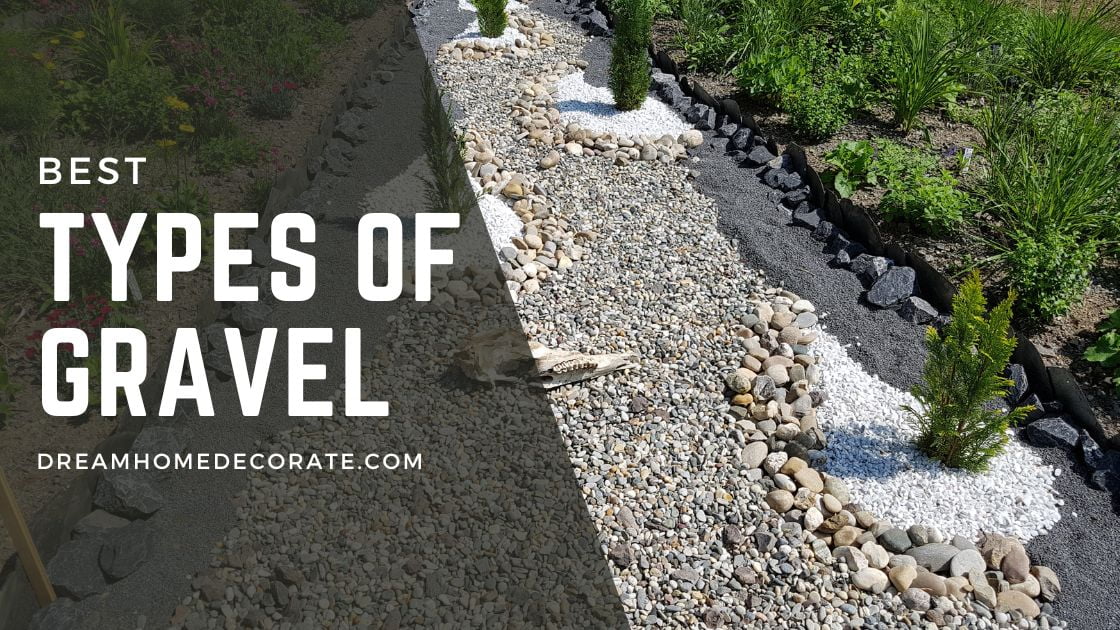There are beautiful types of gravel to choose from. Are you thinking about what type of Gravel you need for your next project? That’s right, not all Gravel is created equal as many different Gravel types can be used for various needs—doing a little research before any investment is always a good idea, the reason why today we’ll be telling you about different types of Gravel.
Gravel is one of the most valuable forms of stone available. Not only do we use stone for decoration and as a critical component in concrete, but it can also be used in paving and a multitude of other landscaping needs.
And with so many options available, sometimes it can get a little challenging knowing what choice to make. Now, do not panic; with the following guide, you’ll get to learn about the different types of Gravel and more valuable tips for your next home décor project.
Types of Gravel
GloFish Aquarium Gravel
This Gravel is specially selected to stand out under the blue lighting in your GloFish aquarium. Add Gravel to your aquarium, decorate with GloFish plants and add your GloFish.
GloFish offers an assortment of brightly colored décor that instantly completes your GloFish environment.
These vibrant plants, accessories, and Gravel come in various shapes, sizes, and colors, allowing you to fully customize your aquarium’s look and feel.
Features:
- Aquarium gravel
- Range of colors
- Fluorescent Highlights
Small Garden Rocks Soil
The white stone is a great choice using as the top dressing bonsai rocks to make gardening or bonsai more fun. At the same time, it is also great for aquarium decoration.
It is a good gravel ornament for your garden, yard garden walkway, or aquarium fish tank. The coarse sand is suitable for home decoration, filled in potted plants, dish gardens, terrariums, and more.
Topdressing would be helpful to avoid having water sit against the lower leaves, keeps soil in place when watering since soil mix is very light and tends to fly everywhere quickly.
Features:
- Natural river rocks
- Non-toxic
- Multifunction
Exotic Pebbles Polished Gravel
Polished Gravel. An alternative to mulch. Use indoors or outdoors. They are long-lasting and will not deteriorate as mulch does.
Use in flower arrangements, walkways, water features, exposed aggregate flooring or walls, around swimming pools, and many other areas. Maybe add a bench as. well. Available in mixed color. Measures 3/8-inch.
Features:
- Use in Water features, Aquariums & ponds
- Perfect for walkways & Driveways
- Polished Gravel
- Use indoors or outdoors
Washed Pea Gravel
Terrarium Rocks and Succulent Gravel. One pound bag of pebbles. Polished River pebbles Can be used for Fairy Garden Rocks. Add drainage—decorative rocks for plants.
Great Gravel for plants. Small pebbles make an excellent soil cover for bonsai, succulents, and Cactus.
Features:
- Decorative rocks
- Small pebbles
- Use for drainage and Indoor Landscaping
Granite Mini Pea Gravel
These stones from just east of Algonquin Park are 100% granitic gneiss; forged in the dawn of our planet, warped one billion years ago in a mountain-building event, and shattered by glaciers into the smooth river rock.
Even at the 1/4 inch size, these stones still display patterns of microcline feldspar, muscovite mica, and classic milky quartz.
Beautiful when wet, these stones are helpful for planters, water features, landscaping, and more. Suitable for aquariums, planters, and terrariums.
Features:
- 100% granitic gneiss
- 1/4 inch diameter rounded Gravel
Common Questions About Types of Gravel
What is Gravel?
Gravel is defined as a tiny stone measuring between 3/16 and 3 inches (4.8 to 75 millimeters) in diameter. They may have round or sharp edges, be smooth or rough, and may be natural or artificial. Stones smaller than 3/16 inches are classified as sands, while those over 3 inches are called rocks.
What is Gravel made of?
Gravel can range in size from tiny sand-like grains of crushed stone to larger rocks left behind by retreating glaciers. Gravel can be made from just about any natural stone and is available in a wide variety of colors. The most common types of rock found in Gravel are basalt, limestone, and sandstone.
What are the three types of Gravel?
The most common varieties of Gravel are:
Man-made Gravel
Man-made Gravel comprises stones that are crushed and filtered using heavy equipment. The term manufacture refers to the way the Gravel is processed. This type of Gravel has sharp edges and is mainly used for road paving projects. Granite is the most common form of manufactured Gravel and is characterized by its white specks or swirls. Larger granite stones are used for driveways and drainage systems, while smaller rocks are used for decorative beds and pathways.
Naturally-Formed Gravel
Naturally-formed Gravel is shaped and broken down by natural sources such as rivers and mountainsides. This type of Gravel is oval and has round edges that are perfect for landscaping projects. Pea gravel is one example of naturally-formed Gravel. It’s small, round, and usually beige or grey. Quartzite is another example and is comparable in both texture and size to pea gravel, albeit with a much brighter color. Quartzite is often mixed with other gravels for pathways, garden decorations, and other similar projects.
Bank Gravel
A Naturally-formed Gravel of any type that is mixed with sand or clay is called bank gravel. Bank gravel has large stones mixed with dirt and smaller stones. It is used to fill low spots in yards and build-up areas where concrete will be placed, such as in driveways.
Pay dirt Gravel
Pay dirt gravel is naturally-formed Gravel that is extracted when panning for gold. This type of Gravel contains precious metals such as silver and gold but may comprise a variety of rock materials.
What is the cheapest type of Gravel?
Crushed concrete, sand and gravel mix, and crushed shells are the cheapest stones at $15 per yard. Crusher run, pea gravel, steel slag, and river rock typically cost $50 per yard or more.
What is the best surface gravel for driveways?
- Crushed Stone. It is crushed up stone combined with rock dust. This mixture can handle moderate traffic from heavy vehicles.
- Quarry Process. It is also called “crusher run” and works well for the surface of both driveways and walkways. It’s made from stone dust fines and crushed stone. The stone dust will settle and become compact to create a semisolid surface that is smooth.
- Pea Gravel. Pea gravel is popular Gravel for driveway aesthetics. It’s made up of round, small stones that can come in many different colors.
- Jersey Shore Gravel. It is made of yellow, tan, white, gold, and brownstones and looks like sand. It’s similar to pea gravel since it needs borders or stabilizing pavers to prevent it from spreading.
- Marble Chips. Marble chips are white, and they sparkle in the sunlight. They typically cost more than other gravel types but are another favorite for being the best Gravel for driveway aesthetic appeal.
- Blackstar or Blackstrap Rock. A lovely dark gray gravel, this is an excellent choice as it is angular and locks together. When combined with stabilizing grid paving system, this provides a super durable and beautiful driveway.
Which Gravel is best?
Based on appearance, longevity, and purpose, Jersey Shore gravel and pea gravel are considered the best types of Gravel for driveways. Marble chips, quarry process, and river rock are some of the best rocks for driveways and crushed stone #3 and item #4 as the best stones for driveways.
What type of Gravel is best for landscaping?
- Decomposed Granite. It is usually reddish-tan and sandy and provides landscapes with a soft, rustic look. This affordable option is often used around trees, garden trails, and as a xeriscape ground cover.
- Crushed Granite Gravel. This Gravel has larger particles than decomposed granite and provides a nice, natural look for your yard. It makes a good transition between garden plants and pathways.
- Lava Rock. Composed of actual lava from volcanoes, this rock boasts explosively bold colors, providing a pretty accent to any landscape design. It is ideal for drier climates, absorbing heat during the day and releasing it throughout the night.
- River Rock. You don’t have to live by a river for your landscape to rock. River rocks are smoother in texture and larger than pea gravel. Pull together their different hues to create pretty garden borders or dry creek beds.
- Flagstone. Along with smaller pebbles, larger rocks like flagstone are great for stepping stones, garden paths, and walkways between different landscaping elements.
- Brick Chips. This next one isn’t technically a rock, but it’s still a popular choice for hardscapes. Brick chips are made from crushed fragments of bricks and come in reddish and brown hues. These chunks are great for driveways and landscaping paths.
- Marble Chips. Marble isn’t just for the kitchen anymore. Marble chips are sleek and classy options to cover the soil around container gardens and landscaping design elements.
What types of Gravel are suitable for garden use?
- Lag Gravel: This coarse form of Gravel is the material left over after sifting more refined gravel grains. It tends to be used as a filler material.
- Navajo Sandstone: 3/8 to 3/4 inch natural gravel known for its many mixed colors.
- Piedmont Gravel: gravel stones carried and shaped down mountainsides by streams to flat areas.
- Slate Gravel: Fine-grain gravel made from crushed slate



